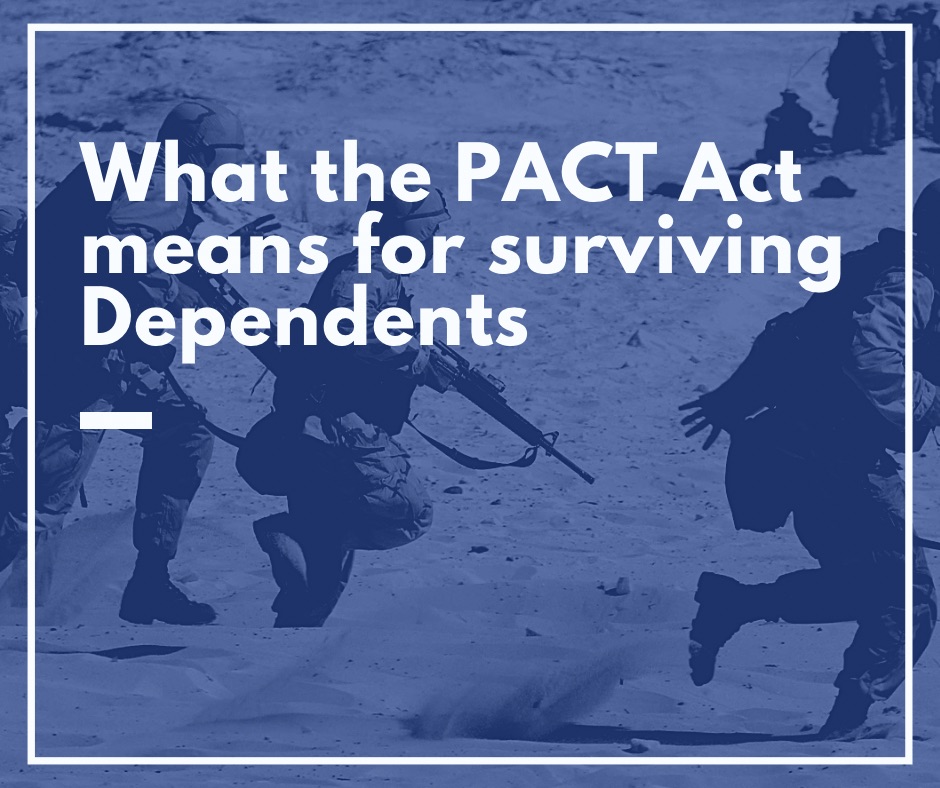Transforming Veteran Care: What the PACT Act Means for Survivors
Survivor Benefits and the PACT Act
A few years ago I was talking to a Veteran who had made an emergency landing at U-Tapao Airbase in Thailand during the Vietnam War. He had evidence of being at the Airbase, but no actual evidence of being located around the fenceline, which is the only place that the VA was willing to say Agent Orange may have been used.
Fast forward to Aug 10, 2021 and the signing of the PACT Act. The Veteran was now eligible to file for his presumptive disability. Part of the PACT Act added additional areas to the presumptive list for Agent Orange exposure. Those areas include all USA and Royal Thai military bases in Thailand.
If you haven’t heard about the PACT Act by now, you need to read up on it. The Act opened the door for many Veterans to receive compensation who were not eligible to receive it before. Specifically, the Act made certain conditions presumptive for those who served in the first Gulf War and those who have served in several overseas areas since 9/11. For a full list of the areas covered under the act you can see this post.
The Act also included new conditionals for Vietnam Veterans exposed to Agent Orange, and even more importantly, added several areas to the Agent Orange presumptive list. These areas include all US and Thai bases in Thailand, Johnson’s Atoll, and other areas. You can see the full list here.
So what does this mean for survivors?
If a Veteran passed away in the past from a condition presumptive to Agent Orange, but they were located in one of the areas added in the PACT Act, their death can retroactively be service connected. This means that if the survivor was not eligible for DIC at the time of the Veterans death, they may very well be eligible for it now.
The same type of retroactive findings can also apply to Veterans from the first Gulf War or Veterans who deployed since 9/11. If they passed away from one of the several presumptive conditions the VA has listed for toxic exposure, the survivors may be eligible for DIC where they were not eligible before.
For example, say SPC Snuffy was deployed to Afghanistan in 2005. SPC Snuffy redeployed successfully, but ten years down the road was diagnosed with Lung Cancer and passed in 2016. In 2016, according to the VA, there was no presumed linkage between service in Afghanistan and lung cancer. Therefore, the Veteran’s spouse would not be eligible for DIC. After passage of the PACT Act, SPC Snuffy’s surviving spouse could now file for DIC and would likely receive it because respiratory cancers of all types have been presumed to be linked to service in Afghanistan along with several other countries.
The bottom line is, if a Veteran has passed from one of the presumptive conditions, it would probably behoove their survivor to look at the list of presumed conditions, make sure they know where their Veteran was and if they were in one of the affected areas, and if so file for DIC.
Hopefully this has provided some useful information. If you have any questions or comments, you can leave them below or email us at info@nwavet.org.








My husnand George Pflomm passed away August 31 2024 and he did served in the Navy , still no answers of why he died ,I am his wife and trying to figure what iam suppose to do now ????
First, I am sorry to hear about your loss. I am including a link to a resource from us about this exact situation. We always suggest contacting your local Veteran Service Officer for assistance, especially in a time of loss like this. VSOs deal with VA paperwork every day, and can assist you in filing the correct paperwork. Here is the link to the pamphlet: https://nwavet.org/wp-content/uploads/2023/05/Next-Steps.pdf